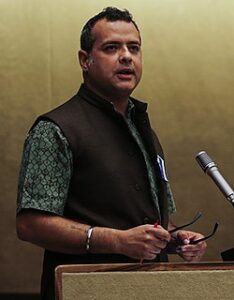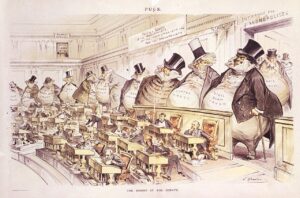The Banana Road From South America To China

Vijay Prashad
01-05-2025 ~ In November, Álvaro Noboa, the father of Ecuador’s president Daniel Noboa, had a heart attack. He was hastily taken to a clinic in Guayaquil, his hometown, and then after he was stabilized, flown to a hospital in New York. Álvaro Noboa unsuccessfully ran for president five times (1998, 2002, 2006, 2009, and 2013), but it was his son who prevailed in 2023 at the age of 35. What defines the Noboa family is not political office, but the wealth of the Noboa Corporation. Grupo Noboa was formed out of Bananera Noboa S.A. set up in 1947 by Luis Noboa Naranjo, the grandfather of the current president. Bananera Noboa expanded, thanks to Álvaro, into the Exportadora Bananera Noboa, which is the heart of the Group’s billion-dollar empire in Ecuador (population 18 million, a third of whom live below an abysmally low poverty line). The name of the expanded firm has two words in it that describe the hold of the Noboa family on the Ecuadorian economy and on its political life: the export (exportadora) of bananas (bananera).
Banana Trade
Countries other than Ecuador produce a very large share of the world’s banana product. India produces more than a quarter of bananas, while China produces a tenth. But these are not banana-exporting countries because they have enormous domestic markets for bananas. More than 90 percent of the world’s exported bananas come from Central and South America as well as the Philippines. Ecuador, which only produces a little over 5 percent of the world’s banana produce, exports 95 percent of its production, making up 36 percent of the world’s exported bananas (Costa Rica is next at 15 percent). Grupo Noboa is Ecuador’s largest banana firm, and therefore one of the most important companies in the export of bananas globally. The largest importers of bananas are the European Union (5.1 million tons), the United States (4.1 million tons), and China (1.8 million tons). Europe and the United States have established suppliers in Central and South America (Colombia, Costa Rica, Ecuador, and the Dominican Republic), and neither experience major supply shortages. Read more
Trump Has Stuffed His Cabinet With Oligarchs Poised To Govern For Their Profit

The Bosses of the Senate, a cartoon by Joseph Keppler. First published in Puck 1889.
01-05-2025 ~ The circle of billionaires in Trump’s cabinet embodies the reign of American oligarchy.
In the narrative of mainstream U.S. media, oligarchs — super-rich, politically connected individuals with influence over the state — exist only in post-communist countries and post-colonial societies in Latin America, Asia and Africa. Their power is seen as a foreign, un-American deviation from capitalism. In reality, however, the United States’ own oligarchs are thriving.
The U.S., despite the continued reverie expressed for democratic ideals, has shown to be a full-fledged plutocratic oligarchy — and for the next four years, it will be run directly by the oligarchs themselves. President-elect Donald Trump has assembled an administration of billionaires and warmongers whose combined wealth runs into hundreds of billions of dollars.
In a way, there is nothing surprising about this disturbing development. The rich in the U.S. have seen their wealth rise dramatically over the past 30 years, and the last four years have been particularly great for billionaires. Most people in the U.S. think that the economy works only for the rich and the powerful. Read more
How The World Hides Liability For Climate Deaths
 01-04-2025 ~ Unfair family planning regimes have stalled progress in the climate fight and prevent children from having a fair start in life.
01-04-2025 ~ Unfair family planning regimes have stalled progress in the climate fight and prevent children from having a fair start in life.
Nearly half the world’s children “live in countries where risks to their health and safety due to the effects of climate change are extremely high,” according to UNICEF. By 2050, almost all children globally will be “exposed to heat waves,” resulting in the rise of specific health issues, especially for smaller children, adds the agency.
Rich nations’ inability or unwillingness to curb their emissions has exacerbated the climate crisis, which, if left unchecked, may unfold apocalyptic scenarios. Those most responsible for the climate crisis spent decades funding denialism while robbing children and animals of the future they deserve. They exploited the world’s people and resources while hoarding wealth for themselves.
The outcome of the 2024 United Nations Climate Change Conference, or COP29, held in Baku, Azerbaijan, is a shining example of how rich countries are reluctant to take remedial steps to secure the children’s and the planet’s future. The COP29 was widely criticized for the rich world’s failure to adequately address developing nations’ critical climate-related financing needs.
“The latest NCQG [New Collective Quantified Goal on Climate Finance] decision at COP29 starkly highlights the unwillingness of developed and oil-rich nations to take responsibility for their historical and substantial emissions,” said Pegah Moulana, the secretary general of Youth and Environment Europe, the largest independent platform of environmental youth organizations in Europe. “By failing to provide concrete support to the most affected states and neglecting to establish a robust protocol to ensure these nations remain debt-free during implementation, the decision exacerbates climate injustice.”
According to a 2024 analysis by the International Institute for Environment and Development, the poorest countries and those most vulnerable to climate change spend “more than twice as much to service their debts as they receive to fight the climate crisis.” Read more


